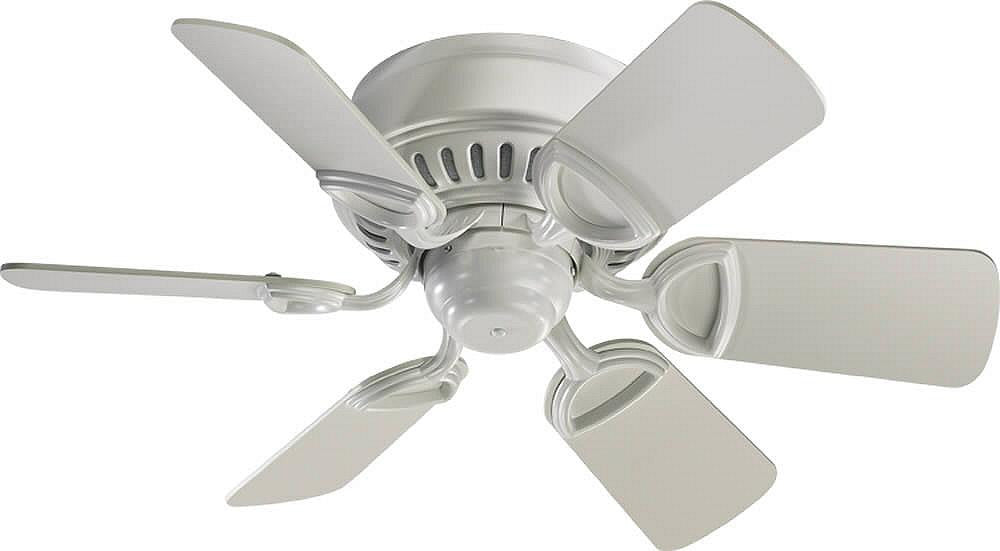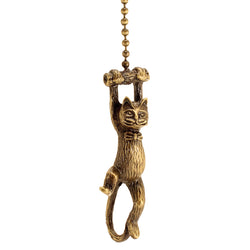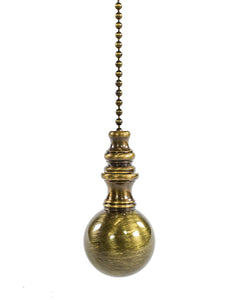Quorum 30"W Medallion Hugger 6-Blade Ceiling Fan Studio White

30"W Medallion Hugger 6-Blade Ceiling Fan Studio White
This Medallion Ceiling Fan, finished in attractive Studio White, is the perfect touch to complement your home or office decor.- Studio White Finish
- Traditional style
- 6 x Studio White Blades
- 6 blades with a 30" total blade-span and 25-degree blade pitch
- Overall fan height: 8"
- Height from ceiling to bottom of blades: 7.75"
- Housing Width: 10.71"
- Motor Size: 153mm x 12mm
- Features a 14-Pole Motor
- Detachable Switch Cup for optional light kit installation (light kit not included)
- Skirted Blade Arms
- Three unique speed settings
- Amps: 0.44 on High, 0.32 on Medium, 0.19 on Low
- Watts: 52 on High, 26 on Medium, 9 on Low
- Revolutions per Minute: 209 RPM on High, 153 RPM on Medium, 89 RPM on Low
- Includes a pull-chain switch with High/Medium/Low/Off settings
- Fan may be run in reverse using a switch on the fan motor
- Includes 8" of Lead Wire
- Limited Lifetime motor warranty
- Does NOT include a remote control
- Compatible with the 7-3000 Remote Control from Quorum (not included)
- Part of the Medallion Collection by Quorum International
- UL Listed for Indoor/Dry locations (not damp or wet)
- Weight: 14.95 lbs
| Revolution Speed (RPM - Revolutions per Minute) | Air Flow (CFM - Cubic Feet of Air Flow per Minute) | Electricity (Watts - Electricity used not including any Lights) | Efficiency (CFM/Watt - Cubic Feet of Air Flow per Minute per Watt used - higher is better) | AMPs (Amperage of Electrical Current used) | |
| HIGH Speed | 209 | 3350 | 53 | 63 | 0.44 |
| MEDIUM Speed | 153 | 26 | 0.32 | ||
| LOW Speed | 89 | 9 | 0.19 | ||
| Efficiency is the cubic feet of air that can be moved in one minute if the fan were to use 1 watt of electricity, and can be used to compare energy-efficiency among different ceiling fans. The higher this number the more energy-efficient the fan is. This ceiling fan's airflow efficiency is below average, compared to fans with less than a 52" blade span. By comparison, other small-sized ceiling fans with less than a 52" blade span typically provide an airflow efficiency ranging from 38 to 82 cubic feet per minute per watt. | |||||
Product Overview
The 30"W Medallion Hugger 6-Blade Ceiling Fan in Studio White is a stylish and functional addition to any home or office. With its sleek design and traditional style, this ceiling fan is perfect for enhancing the aesthetic appeal of your space while providing optimal air circulation.
Design and Style
This ceiling fan features a beautiful Studio White finish that adds a touch of elegance to any room. The six blades are also finished in Studio White, creating a cohesive and polished look. The fan's compact design, with a 30" total blade-span and a 25-degree blade pitch, ensures that it fits seamlessly into smaller spaces without compromising on performance.
Features and Benefits
The Medallion Hugger Ceiling Fan is equipped with a powerful 14-Pole Motor, ensuring efficient and reliable operation. The fan offers three unique speed settings—High, Medium, and Low—allowing you to customize the airflow to your preference. With a maximum revolution speed of 209 RPM, this fan provides excellent air circulation, making it ideal for maintaining a comfortable environment in your home or office.
The fan's energy performance is noteworthy, with an airflow efficiency that compares favorably to other small-sized ceiling fans. It operates at 52 watts on High, 26 watts on Medium, and just 9 watts on Low, making it an energy-efficient choice for any space. Additionally, the fan includes a pull-chain switch with High/Medium/Low/Off settings, offering convenience and ease of use.
Versatile Usage
This ceiling fan is perfect for various rooms and settings. Its compact size and traditional style make it an excellent choice for bedrooms, home offices, kitchens, and small living areas. The fan's low profile design, with an overall height of just 8", makes it ideal for rooms with low ceilings. The height from the ceiling to the bottom of the blades is 7.75", ensuring adequate clearance and safe operation.
The Medallion Hugger Ceiling Fan is UL Listed for indoor/dry locations, making it suitable for most indoor environments. It can be installed in various locations within a room, such as above seating areas, workspaces, or dining tables, to provide optimal airflow and comfort. The fan's traditional style complements a wide range of room themes, including classic, contemporary, and transitional decor.
Additional Features
The fan includes a detachable switch cup, allowing for optional light kit installation (light kit not included). This feature provides added versatility, enabling you to enhance the functionality of the fan by incorporating lighting if desired. The fan also includes 8" of lead wire, ensuring easy installation and setup.
For added convenience, the fan can be run in reverse using a switch on the fan motor. This feature is particularly useful during the winter months, as it helps to circulate warm air throughout the room, enhancing overall comfort and energy efficiency.
Order Now
Enhance the comfort and style of your home or office with the 30"W Medallion Hugger 6-Blade Ceiling Fan in Studio White. Its elegant design, efficient performance, and versatile features make it a perfect addition to any space. Order now and experience the benefits of superior air circulation and timeless style.
Recap: The Medallion Hugger Ceiling Fan offers a Studio White finish, traditional style, and a compact design with a 30" blade-span. It features a powerful 14-Pole Motor, three-speed settings, and energy-efficient operation. Ideal for various rooms and decor styles, this fan is a versatile and stylish choice for enhancing your indoor environment. Don't miss out—order yours today!

What is an Ceiling Fan?
 A ceiling fan is a fairly large ceiling-mounted fan which can rotate clockwise or anticlockwise. In one direction the fan blows air downward, while in the other it draws air upwards. Some fans come equipped with a light fixture to double as a central light. The fan is a hardwired fixtures so has to be installed electrically. Typically it is used with a wall switch or remote control. Ceiling fans can help keep you cool in summer and also warmer in winter by circulating the air.
A ceiling fan is a fairly large ceiling-mounted fan which can rotate clockwise or anticlockwise. In one direction the fan blows air downward, while in the other it draws air upwards. Some fans come equipped with a light fixture to double as a central light. The fan is a hardwired fixtures so has to be installed electrically. Typically it is used with a wall switch or remote control. Ceiling fans can help keep you cool in summer and also warmer in winter by circulating the air.
Ceiling Fan Benefits
- Circulates air for healthier breathing.
- Reversible direction for summer/winter.
- Blows air onto bodies for direct cooling.
- Draws hot air upwards for ambient cooling.
- Optional speeds for varying effect.
- May add to lighting (if light is included or addedd).
- Saves on electrical heating bills.
- Keeps rooms fresher and helps remove odors.
- Provides a gentle breeze over a bed or chair.
- Usually can be manually (pull chain) or wall (switch) operated.
- Helps to remove or distribute hot rising air.
Traditional Style
Classic in nature, yet elegant by design best describes the timeless appeal of predictable yet dignified lines and curves. Traditional Style Lighting prides itself on stately structure, beautiful ornate details, and reliable designs that tell a story of enduring appeal and craftsmanship. It’s a tried-and-true style that is reliable, and speaks of discriminating and taste of a steadfast lifestyle.
For which rooms?
A ceiling fan needs enough headroom, so is ideal over some furniture such as a couch, seating area or bed. See hugger fans for maximizing headroom. Fans are most often used in living rooms, family rooms and bedrooms, where people might be dwelling for a longer period of time.
Placement/Layering
A fan is best positioned either centrally in the room or above a main seating or sleeping area. If the fan has a light it can help to light the room. We recommend adding either wall lights or some lamps to fill out the space.
Mounts to the Ceiling
Attaches to a ceiling. The ceiling should be flat, unless the fan supports sloped/vaulted ceilings. A small canopy will conceal the electrical installation.
Installed by an Electrician
An electrician or person with electrical installation knowledge will need to permanently wire the ceiling fan into the building's electrical supply.
Resources
Learn how to choose ceiling fans with our Energy Star lighting
We've shopped for you!
You're getting the the lowest prices, guaranteed!
Thousands of items are on sale every day. Plus you're tax-free unless you live in Wisconsin.
Want a different price? Contact us for a personalized quote.
Safely checkout with our world-class encryption.
Trusted by over 100,000 customers, your private and payment data is secure and will not be shared.
We accept Visa, Mastercard, Discover and Paypal. Credit cards can also be processed through Paypal.
Spend $49.00 to get Free Shipping (contiguous USA).
Most other items ship for $9 in 1-3 business days (contiguous USA). QuickShip items ship out the next business day.
Depending on your location, shipments take on average 3-5 business days or up to 7-10 from coast to coast. We ship from multiple locations.
You will receive tracking numbers by email when your items ship out, via Fedex, UPS or USPS.
You'll be able to track the packages online or on our site.
You can also talk to our team of experts at any time, or Live Chat.
Enjoy 30 days for easy returns. See our return policy for details.
We replace breakages/damages/missing parts etc for free.
Every item is covered under our extended 1-year warranty.





